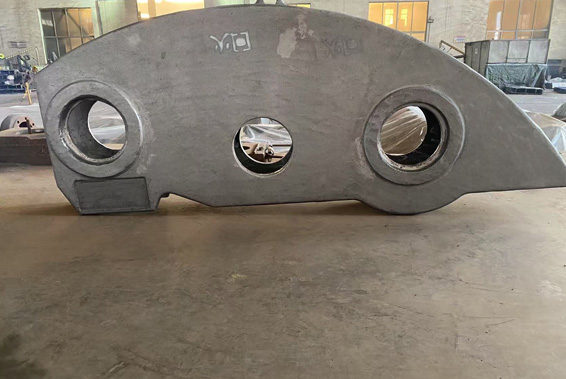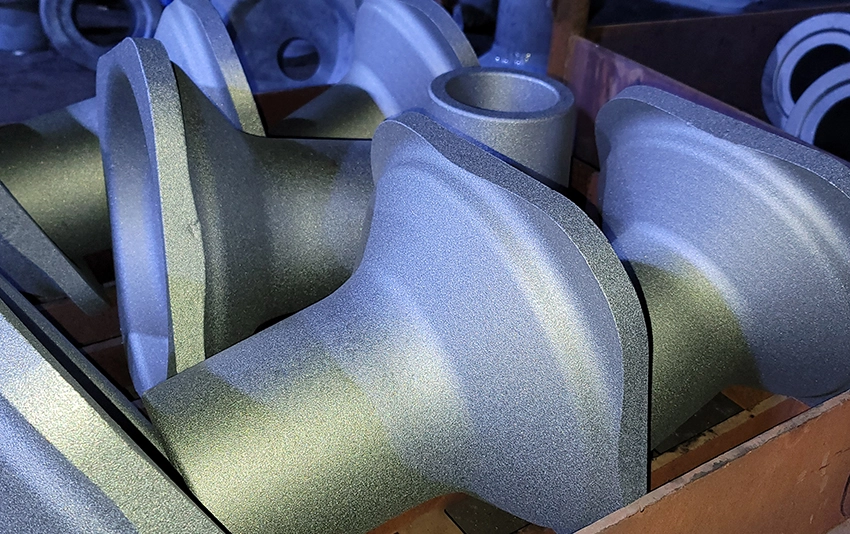Low Alloy Casting Steel Cap for Metal Recycling Shredders
Overview of Low Alloy Casting Steel Caps
Low alloy casting steel caps are critical wear-resistant components designed to protect the rotors of metal recycling shredders from abrasive and high-impact conditions. Crafted from premium low alloy steels, specifically 4140-Modified and 4340-Modified, these caps shield rotor assemblies from damage during the processing of ferrous and non-ferrous scrap, significantly extending the operational life of shredders. With a hardness of 42–44 HRC after quenching and tempering (Q&T), these caps offer superior durability and impact resistance. Compatible with leading shredder brands like LINDEMANN, Metso Outotec, Shred-Tech, and Sierra, WALKSON’s low alloy casting steel caps deliver reliable performance in demanding recycling applications.
Our commitment to quality is reinforced through rigorous quality control measures, including Advanced Product Quality Planning (APQP), Process Failure Mode and Effects Analysis (PFMEA), Production Part Approval Process (PPAP), and First Article Trial (FAT). These processes ensure that every cap meets stringent industry standards and client specifications. Whether you operate high-throughput shredders or specialized metal processing systems, WALKSON’s caps provide unmatched durability, impact resistance, and cost-efficiency.
Key Functions and Material Benefits
· Rotor Protection: Acts as a sacrificial wear part, absorbing impacts and abrasions to safeguard rotor assemblies, reducing downtime and maintenance costs.
· High-Strength Materials: Manufactured from 4140-Modified and 4340-Modified low alloy steels, offering exceptional hardness (42–44 HRC post-Q&T), toughness, and fatigue resistance.
· Impact Resistance: Engineered to withstand repetitive high-impact forces from crushing scrap metal, ensuring long-lasting performance.
· Compatibility: Precision-designed for seamless integration with major shredder models, including LINDEMANN, Metso, and Shred-Tech systems.
· Cost Efficiency: Extends rotor lifespan, minimizing replacement frequency and operational disruptions.
Modern and Standardized Manufacturing Process
WALKSON employs a state-of-the-art manufacturing process for low alloy casting steel caps, guided by international standards and advanced quality planning methodologies like APQP to ensure product reliability, consistency, and performance. Our process adheres to ISO 9001:2015 (Quality Management Systems) and ASTM A148 (Standard Specification for Steel Castings, High Strength, for Structural Purposes), with additional QC measures to meet client expectations.
1. Advanced Product Quality Planning (APQP):
Initiated at the project outset to define quality objectives, design specifications, and production processes.
Involves cross-functional teams (engineering, metallurgy, quality assurance) to align with client requirements and industry standards.
Ensures traceability and compliance with ISO/TS 16949 (Quality Management for Automotive and Industrial Components), where applicable.
Outputs include process flow charts, control plans, and risk assessments, setting the foundation for PFMEA.
2. Process Failure Mode and Effects Analysis (PFMEA):
Conducted during APQP to identify potential failure modes in the manufacturing process (e.g., casting defects, dimensional inaccuracies).
Risks are prioritized using Risk Priority Numbers (RPN) and mitigated through corrective actions, such as enhanced mold design or stricter material controls.
PFMEA ensures robust process reliability, reducing defects and ensuring compliance with AIAG (Automotive Industry Action Group) guidelines.
3. Material Selection:
High-quality 4140-Modified and 4340-Modified low alloy steel grades are sourced from certified suppliers, meeting ASTM A29/A29M (Standard Specification for General Requirements for Steel Bars, Carbon and Alloy, Hot-Wrought).
Modified compositions enhance strength and toughness, tailored for shredder applications.
Raw materials undergo spectrographic analysis to verify alloy content (e.g., chromium, molybdenum, nickel).
4. Pattern and Mold Making:
Precision patterns are created using CAD/CAM software and CNC machining for accurate mold cavities.
Sand molds are prepared using automated molding systems, complying with ISO 8062 (Dimensional Tolerances for Castings).
5. Melting and Casting:
Steel is melted in electric arc furnaces (EAF) or induction furnaces, ensuring uniform composition and minimal impurities.
Molten steel is poured into molds under controlled conditions, adhering to ASTM E781 (Standard Practice for Evaluating Absorptive Materials in Castings).
6. Heat Treatment:
Castings undergo quenching and tempering to achieve a hardness of 42–44 HRC, following ASTM A370 (Standard Test Methods and Definitions for Mechanical Testing of Steel Products).
Heat treatment parameters are monitored using automated furnaces, complying with AMS 2750 (Pyrometry Standards).
7. Machining and Finishing:
Caps are machined using CNC lathes and milling machines for precise dimensions and surface finish, meeting ISO 2768 (General Tolerances).
Surface treatments, such as shot blasting, enhance durability and appearance.
8. First Article Trial (FAT):
A First Article Trial is conducted to produce and evaluate an initial sample cap from the production process, ensuring it meets all design and performance specifications, including 42–44 HRC hardness.
FAT involves comprehensive testing (see Testing Procedures below) and dimensional verification to confirm compatibility with shredder systems.
Clients or third-party inspectors may witness FAT, with detailed reports provided to validate the trial results before full-scale production.
FAT results feed into the PPAP submission, ensuring alignment with client requirements.
9. Production Part Approval Process (PPAP):
Implemented to validate production processes before full-scale manufacturing, incorporating FAT results and ensuring caps meet client specifications and industry standards.
PPAP documentation includes material certifications, dimensional reports, control plans, PFMEA results, and FAT reports, submitted to clients for approval.
Complies with AIAG PPAP requirements, ensuring consistency for clients in industries like recycling and heavy machinery.
10. Quality Control:
Each cap undergoes rigorous inspection (see Testing Procedures below) to ensure defect-free performance and compliance with 42–44 HRC hardness requirements.
Quality controls are defined during APQP and monitored through PFMEA, with PPAP ensuring process validation.
Equipment Involved:
· Melting: Electric arc furnaces, induction furnaces.
· Molding: Automated sand molding systems, resin-bonded sand mixers.
· Machining: CNC machining centers, lathes, milling machines.
· Heat Treatment: Automated quenching and tempering furnaces.
· Inspection: Ultrasonic testing (UT) machines, magnetic particle testing (MT) equipment, dye penetrant testing (PT) systems, coordinate measuring machines (CMM).
International Standards Guiding Production
WALKSON’s manufacturing process complies with globally recognized standards to ensure product reliability and traceability:
· ISO 9001:2015: Quality management system for consistent production.
· ASTM A148/A148M: Specifications for high-strength steel castings.
· ASTM A29/A29M: Requirements for alloy steel grades (4140-Modified, 4340-Modified).
· ISO 8062: Dimensional tolerances for castings.
· ASTM E781: Evaluation of casting quality.
· AMS 2750: Heat treatment pyrometry standards.
· ISO 2768: General tolerances for machined components.
· ISO/TS 16949: Quality management for industrial components (APQP, PPAP, FAT).
· AIAG Guidelines: For PFMEA, PPAP, and FAT processes.
Testing Procedures and Protocols
To ensure the integrity of our low alloy casting steel caps, WALKSON implements comprehensive testing protocols in accordance with international standards, integrated with APQP, PFMEA, FAT, and PPAP requirements. Testing verifies the 42–44 HRC hardness and overall quality. Clients are invited to witness these tests, including the First Article Trial, and third-party inspectors (e.g., SGS, Bureau Veritas, or client-designated agencies) are welcomed to oversee the process, ensuring transparency and confidence in our products.
1. Non-Destructive Testing (NDT):
o Ultrasonic Testing (UT): Performed per ASTM A609 (Standard Practice for Castings, Ultrasonic Examination) to detect internal flaws such as voids or inclusions.
o Magnetic Particle Testing (MT): Conducted per ASTM E709 (Standard Guide for Magnetic Particle Testing) to identify surface and near-surface defects.
o Dye Penetrant Testing (PT): Applied per ASTM E165 (Standard Practice for Liquid Penetrant Examination) to detect surface cracks or porosity.
2. Dimensional Inspection:
o Conducted using coordinate measuring machines (CMM) and precision gauges to verify compliance with ISO 8062 tolerances.
o Gauging inspection ensures dimensional accuracy for compatibility with shredder rotors, documented in PPAP and FAT reports.
3. Mechanical Testing:
o Hardness Testing: Performed per ASTM E10 (Brinell Hardness) or ASTM E18 (Rockwell Hardness) to confirm hardness levels of 42–44 HRC.
o Tensile Testing: Conducted per ASTM A370 to verify yield strength, tensile strength, and elongation.
o Impact Testing: Performed per ASTM E23 (Charpy V-Notch) to assess toughness under impact loads.
4. Chemical Composition Analysis:
o Spectrographic analysis ensures compliance with ASTM A29/A29M for alloy content of 4140-Modified and 4340-Modified steels (e.g., carbon, chromium, molybdenum).
5. Visual Inspection:
o Conducted per ASTM A802 (Standard Practice for Steel Castings, Surface Acceptance Standards) to ensure surface quality.
6. First Article Trial (FAT) Testing:
o The First Article Trial involves producing a sample cap and subjecting it to all applicable tests (UT, PT, MT, dimensional, mechanical, and chemical analysis), including verification of 42–44 HRC hardness.
o FAT ensures the production process yields a component meeting design specifications and performance requirements.
o Results are documented in a First Article Inspection Report (FAIR), included in the PPAP submission, and shared with clients for approval.
Client Oversight:
· Clients may schedule on-site visits to witness UT, PT, MT, gauging inspections, and FAT at WALKSON’s facilities.
· Third-party inspectors are welcomed to verify compliance with standards, FAT results, and PPAP requirements.
· Comprehensive test reports, FAIR, PPAP documentation, and certificates of conformity are provided for traceability.
Advantages of Choosing WALKSON
· Uncompromising Quality: Our low alloy casting steel caps, made from 4140-Modified and 4340-Modified steels with 42–44 HRC hardness, are manufactured with APQP, PFMEA, PPAP, and FAT, ensuring defect-free performance and compliance with global standards.
· Customization: Tailored solutions to match specific shredder models and operational requirements, validated through FAT and PPAP.
· Global Compatibility: Designed for seamless integration with LINDEMANN, Metso, Shred-Tech, and other leading shredders.
· Transparent Quality Assurance: Client and third-party oversight of testing and FAT, backed by detailed PPAP documentation and FAIR, ensures confidence in product integrity.
· Risk Mitigation: PFMEA identifies and eliminates potential failure modes, delivering reliable components.
· Expert Support: Our team of engineers and quality specialists provides technical consultation to optimize component performance.
· Competitive Pricing: High-quality products at cost-effective prices, delivering value to your operations.
· Reliable Supply Chain: Global logistics network ensures timely delivery to clients in the EU, USA, Australia, and beyond.
Call-to-Action
Elevate your metal recycling operations with WALKSON’s low alloy casting steel caps, crafted from 4140-Modified and 4340-Modified steels with 42–44 HRC hardness, backed by APQP, PFMEA, PPAP, and First Article Trial for unmatched quality. Contact us today for custom solutions, detailed specifications, or to schedule a consultation. Email us at info@walkson.com (mailto:info@walkson.com) or reach out via WhatsApp/WeChat for prompt assistance. Request a quote now and experience the WALKSON difference!
 English
English  Deutsch
Deutsch  français
français  русский
русский  فارسی
فارسی  العربية
العربية  Español
Español  日本語
日本語  한국어
한국어  italiano
italiano  português
português  dansk
dansk  Suomi
Suomi 








